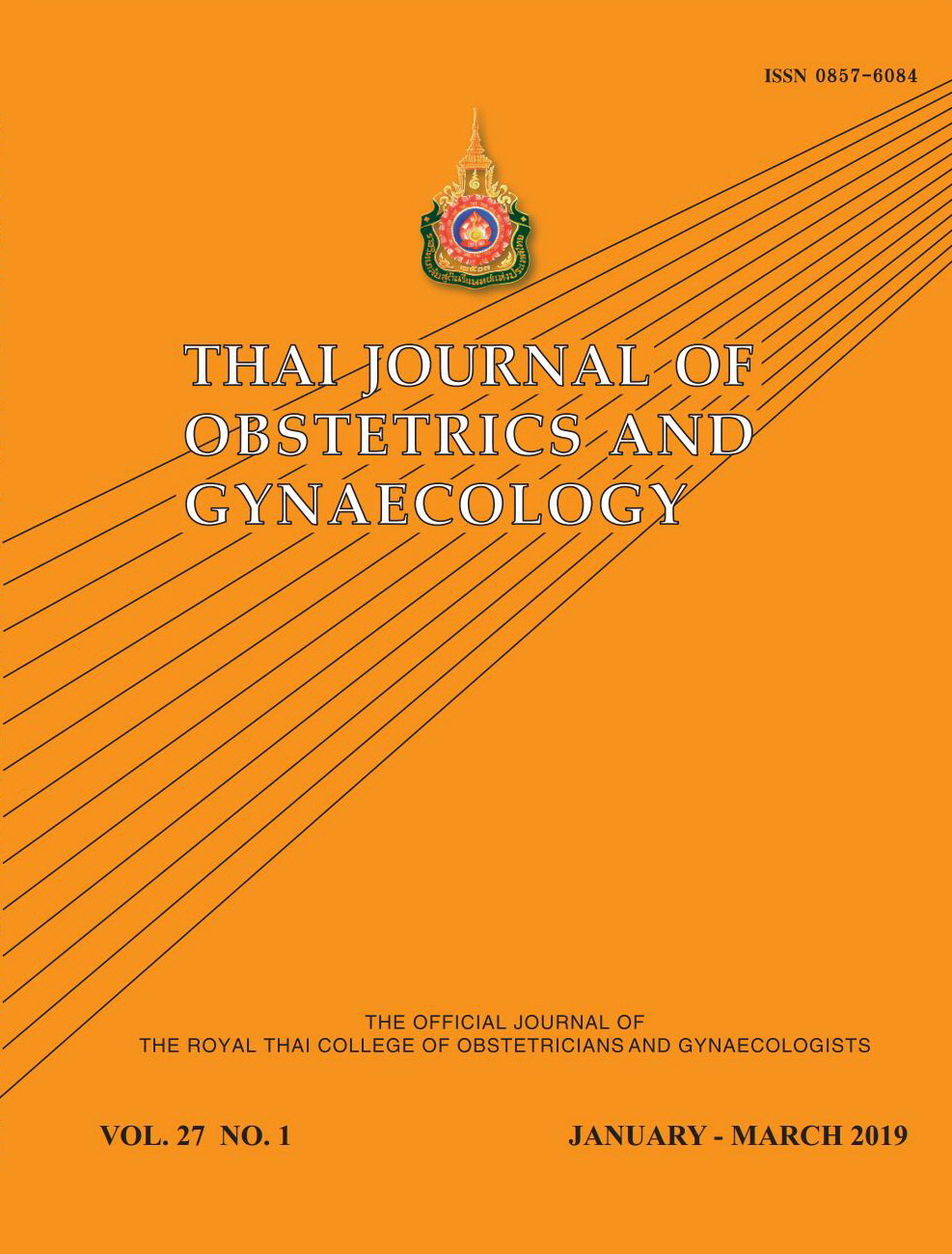Comparison of Vaginal pH between Bacterial Vaginosis and Non-bacterial Vaginosis in Preterm Labour
Main Article Content
Abstract
Objectives: The aim of this study was to compare vaginal discharge pH between bacterial vaginosis (BV) and non-bacterial vaginosis in preterm labour.
Materials and Methods: An analytical cross-sectional study was carried out on patients admitted to the obstetrics ward of Prapokklao Hospital from June 2016 to January 2017. The main inclusion criterion was the presence of preterm labour without premature rupture of membranes or vaginal bleeding. Vaginal discharge was collected for pH measurement and Gram stain. The Nugent criteria from the University of British Columbia were used for BV diagnosis.
Results: The final analysis was based on data from 105 participants. The prevalence of BV was 71.4%. The mean of vaginal pH was 5.97±0.40 for the BV group and 5.20±0.36 for the non-BV group, z=6.674, p < 0.001.
Conclusion: Mean vaginal pH in the BV group was higher than in the non-BV group.
Results: The final analysis was based on data from 105 participants. The prevalence of BV was 71.4%. The mean of vaginal pH was 5.97±0.40 for the BV group and 5.20±0.36 for the non-BV group, z=6.674, p<0.001.
Conclusions: Mean vaginal pH in the BV group was higher than in the non-BV group.
Article Details
References
2. Country data and rankings for preterm birth data EMBARGO UNTIL MAY 2nd 2012 [internet]. 2012 [cited 2017 Jun 13]. Available from https://www.who.int/pmnch/media/news/2012/201204_borntoosoon_countryranking.pdf
3. Saini N, Chhabra S, Chhabra S, Garg L, Garg N. Pattern of neonatal morbidity and mortality: A prospective study in a District Hospital in Urban India. J Clin Neonatol 2016;5:183-8.
4. Henderson J, Carson C, Redshaw M. Impact of preterm birth on maternal well-being and women’s perceptions of their baby: a population-based survey. BMJ Open [Internet]. 2016 [cited 2017 Jun 13];6(10):1-9. Available from: https://bmjopen.bmj.com/content/bmjopen/6/10/e012676.full.pdf
5. Gravett MG, Hitti J, Hess DL, Eschenbach DA. Intrauterine infection and preterm delivery: evidence for activation of the fetal hypothalamic-pituitary adrenal axis. Am J Obstet Gynecol 2000;182:1404-13.
6. Goldenberg RL, Culhane JF, Iams JD, Romeo R. Epidemiology and causes of preterm birth. Lancet 2008;371:75-84.
7. Laxmi U, Agrawal S, Raghunandan C, Randhawa VS, Saili A. Association of bacterial vaginosis with adverse fetomaternal outcome in women with spontaneous preterm labor: a prospective cohort study. J Matern Fetal Neonatal Med 2012;25:64-7.
8. Thanavuth A, Chalermchockcharoenkit A, Boriboonhirunsarn D, Sirisomboon R, Pimol K. Prevalence of bacterial vaginosis in Thai pregnant women with preterm labor in Siriraj Hospital. J Med Assoc Thai 2007;90:437-41.
9. Blake RL Jr, Dilger S, Ingram E, Gay JW. Cervical inflammation and preterm delivery in pregnant women with a history of preterm delivery. J Am Board Fam Pract 1994;7:465-71.
10. Nelson DB, Macones G. Bacterial vaginosis in pregnancy: current finding and future directions. Epidemiol Rev 2002;24:102-8.
11. Mania-Pramanik J, Kerkar SC, Mehta PB, Potdar S, Salvi VS. Use of vaginal pH in diagnosis of infections and its association with reproductive manifestation. J Clin Lab Anal 2008;22:375-9.
12. Cunningham FG, Leveno KJ, Bloom SL, Spong CY, Dashe JS, Hoffman BL, et al. Williams Obstetrics. 24th ed. New York: McGraw-Hill Education 2014;50.
13. Gleeson RP, Elder AM, Turner MJ, Rutherford AJ, Elder MG. Vaginal pH in pregnancy in women delivered at and before term. Br J Obstet Gynaecol 1989;96:183-7.
14. Clinical microbiology proficiency testing: clinical bacteriology [Internet]. 2017 [cited 2017 May 13]. Available from https://ar.scribd.com/document/36931523/Nugent-Score-Interpretation
15. Maclntyre DA, Chandiramani M, Lee YS, Kindinger L, Smith A, Angelopoulos N, et al. The vaginal microbiome during pregnancy and the postpartum period in a European population. Sci Rep [Internet]. 2015 [cited 2017 Jun 13];5. Available from: https://www.nature.com/articles/srep08988.pdf
16. Nuriel-Ohayon M, Neuman H, Koren O. Microbial changes during pregnancy, birth, and infancy. Front Microbiol [Internet]. 2016 [cited 2017 Jun 13];7:1031. Available from: https://journal.frontiersin.org/article/10.3389/fmicb.2016.01031/full
17. Hillier SL, Krohn MA, Klebanoff SJ, Eschenbach DA. The relationship of hydrogen peroxide-producing lactobacilli to bacterial vaginosis and genital microflora in pregnant women. Obstet Gynecol 1992;79:369-73.
18. Myziuk L, Romanowski B, Johnson SC. BVBlue test for diagnosis of bacterial vaginosis. J Clin Microbiol 2003;41:1925-8.
19. Krauss-Silva L, Almada-Horta A, Alves MB, Camacho KG, Moreira ME, Braga A. Basic vaginal pH, bacterial vaginosis and aerobic vaginitis: prevalence in early pregnancy and risk of spontaneous preterm delivery, a prospective study in a low socioeconomic and multiethnic South American population. BMC Pregnancy Childbirth [Internet]. 2014 [cited 2017 Aug 23] ;14:107. Available from: https://www.ncbi.nlm.nih.gov/pmc/articles/PMC3994593/
20. Royce RA, Jackson TP, Thorp JM Jr, Hillier SL, Rabe LK, Pastore LM, et al. Race/ethnicity, vaginal flora patterns, and pH during pregnancy. Sex Transm Dis 1999;26:96-102.


